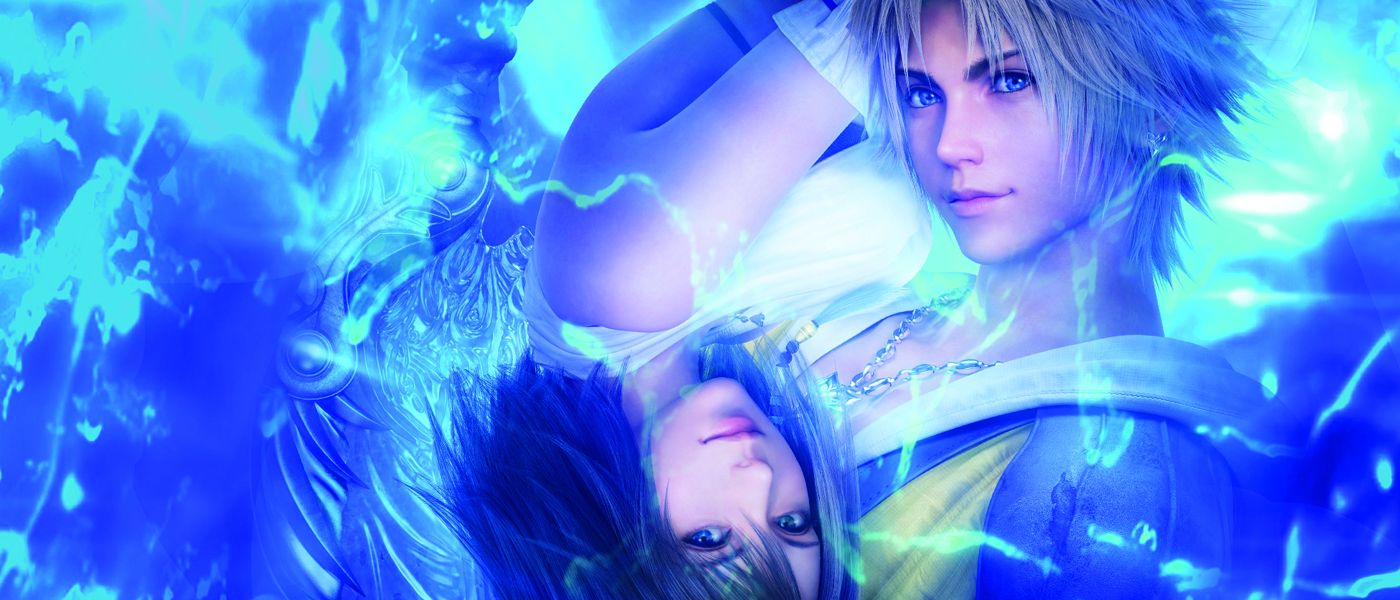 Both the Final Fantasy X games take place within the very well realised world of Spira. Spira has gone through a huge golden age of industrialism, brought about by a mysterious advanced civilisation and their constructions.
Both the Final Fantasy X games take place within the very well realised world of Spira. Spira has gone through a huge golden age of industrialism, brought about by a mysterious advanced civilisation and their constructions.
In a cruel but unusual fate, a malevolent entity known as Sin is conjured to the land to destroy everything to ensure that there is not too much reliance on machines. Only a chosen one – a grand summoner of sorts, can take down Sin.
The first game, Final Fantasy X, follows Tidus, a man who survived an attack from Sin. Through a tumultuous opening scene, he eventually meets up with a summoner named Yuna and attempts to help her on her journey to awaken her true powers. The second game, Final Fantasy X-2, takes place roughly two years after the original game. Yuna has changed as a person, and has settled into her new role in society. But when she notices somebody that looks like Tidus, whom she has grown estranged from, she enlists her closest of friends to discover the origins of the mysterious visage.
The second game, Final Fantasy X-2, takes place roughly two years after the original game. Yuna has changed as a person, and has settled into her new role in society. But when she notices somebody that looks like Tidus, whom she has grown estranged from, she enlists her closest of friends to discover the origins of the mysterious visage.
I’ve always been of the opinion that the story of the Final Fantasy X games are rather well put together, and in the multiple times that the game has been available to players this hasn’t changed at all. The backstory isn’t unnecessarily convoluted and the themes they touch upon – such as the use of religion in a world where science is emerging – still feel as relevant as ever. But it’s all just so cliché, and that’s easily its biggest downfall.
 A little over a year ago, the team who put together the remaster for Final Fantasy X and X-2 managed to do a great job at restoring the environments and making them acceptable for a game rendering in full high definition. The environments and locales have been touched up to look just as good as you remember them looking, without changing up the look of things too much. The Playstation 4 version, while slightly improved, is noticeable clearer when comparing side by side with the Playstation 3 rendition.
A little over a year ago, the team who put together the remaster for Final Fantasy X and X-2 managed to do a great job at restoring the environments and making them acceptable for a game rendering in full high definition. The environments and locales have been touched up to look just as good as you remember them looking, without changing up the look of things too much. The Playstation 4 version, while slightly improved, is noticeable clearer when comparing side by side with the Playstation 3 rendition.
Unfortunately, the issues that plagued the original remaster remain here. Character models still look reasonably better than their original appearances on the Playstation 2, but they’ve been built from the ground up in what I can (still) only describe as being over-styled. Eyes are larger than previously and are less animated than in the original game – which takes away from some more dramatic moments throughout the story as all characters have what can only be described as creepy dead looks on their faces most of the time/
Similarly, the new models haven’t quite been rigged to synchronise their speaking animations with their speech, resulting in a notable issue with lip syncing. As we mentioned in our original review, this was a huge issue with the original game since it was synced to a Japanese voice track, but it feels even more discordant with these new models. Most of the new elements are visually quite nice with the resolution boost, but the entire user interface has been redone too. They’re minor additions but they help bolster the entire package and ensure that it doesn’t feel dated. Similarly, the full motion video cutscenes still look really good and have survived the upscaling process.
Most of the new elements are visually quite nice with the resolution boost, but the entire user interface has been redone too. They’re minor additions but they help bolster the entire package and ensure that it doesn’t feel dated. Similarly, the full motion video cutscenes still look really good and have survived the upscaling process.
From an audio perspective, the Playstation 4 version of both X and X-2 provides the definitive experience. Voice work is still awkward and hammy as hell, but the game provides the option to switch between the new re-arranged soundtrack (introduced in the Playstation 3 version last year) and the original. While this reviewer personally enjoyed the expanded and more modern feel of the re-arranged soundtrack, it’s still a nice option to provide the original tracks for fans of the original. Does it wholeheartedly justify a Playstation 4 re-release though? Probably not.
 Both Final Fantasy X and X-2 still play rather well, putting many of its contemporaries to shame. While it’s a turn based game, the way the game flows makes it still feel just as fast paced as the more recent games in the franchise. There will be some fans who will find it jarring, especially after playing a game as fast paced as Type-0 HD, but generally speaking both games hold up especially well.
Both Final Fantasy X and X-2 still play rather well, putting many of its contemporaries to shame. While it’s a turn based game, the way the game flows makes it still feel just as fast paced as the more recent games in the franchise. There will be some fans who will find it jarring, especially after playing a game as fast paced as Type-0 HD, but generally speaking both games hold up especially well.
Final Fantasy X is the more traditional and conventional of the two. It allows players to input commands via a battle menu and watch them play out in turns. The way that statistics work in the game means that, if you are strategic enough, it’s totally possible to attack twice before your enemy might hit, providing encouragement to pay attention to the management of your characters stats. Final Fantasy X-2 is rooted in tradition but at the same times makes several attempts to reward players who think on their feet and more quickly than a more slower and tactical player. It’s clear the developers intention for X-2 was to provide a game that kept players on their feet, with many movies requiring inputs both before, during and maybe even after their execution. It’s a simple way to make battles feel less monotonous, but it’s important to highlight that both X and X-2 stand up very well today despite their differences.
Final Fantasy X-2 is rooted in tradition but at the same times makes several attempts to reward players who think on their feet and more quickly than a more slower and tactical player. It’s clear the developers intention for X-2 was to provide a game that kept players on their feet, with many movies requiring inputs both before, during and maybe even after their execution. It’s a simple way to make battles feel less monotonous, but it’s important to highlight that both X and X-2 stand up very well today despite their differences.
Similarly, both games feature very different progression systems. In Final Fantasy X, characters are levelled up via the Sphere Grid, which plays like a board game that rewards characters with new skills and stat increases as they pass certain point. It features branching paths and each node on the board usually has something to unlock for the player. Novice players can use the traditional sphere grid to level their characters (across predetermined paths) or more expert players can level each character individually as they see fit to cater to their own play style. The latter mode provides more incentive to play through the game multiple times with different setups but the former is user friendly and approachable too.
Novice players can use the traditional sphere grid to level their characters (across predetermined paths) or more expert players can level each character individually as they see fit to cater to their own play style. The latter mode provides more incentive to play through the game multiple times with different setups but the former is user friendly and approachable too.
Final Fantasy X-2, on the other hand, harkens back to the more traditional “job” based system of older Final Fantasy games. Each of the three playable characters can equip a Dresssphere, which is a costume that grants unique abilities depending on which one is equipped. Each player can take six of these into battle with them and switch between them at well, allowing for adjustments to battle strategy to be made in the heat of battle.
The dressphere system also encourages experimentation by awarding abilities simply by using them multiple times throughout battle. Similarly, dresspheres are brought into battle using Garment Grids, which essentially awards buffs and debuffs depending on the order in which dresspheres are equipped. It’s simple, but effective. In both games, Spira acts as an incredibly diverse and broad playground for players. There’s the main quests, obviously, but there’s also heaps of side quests and mini-games to indulge in to extend the experience. Both games will take most players between forty and fifty hours to complete on a simple story run – but this can easily extend into sixty or even seventy hours of play for each game.
In both games, Spira acts as an incredibly diverse and broad playground for players. There’s the main quests, obviously, but there’s also heaps of side quests and mini-games to indulge in to extend the experience. Both games will take most players between forty and fifty hours to complete on a simple story run – but this can easily extend into sixty or even seventy hours of play for each game.
Thankfully, none of this content ever feels especially boring, especially in Final Fantasy X-2, which employs a mission based system and removes most of the pointless filler. On the flipside, this does mean that there is less opportunity to explore in Final Fantasy X-2 when compared with X but your mileage may vary on how much this poses an issue.
Similar to the Playstation 3 release, the remaster package also includes “Eternal Calm”, which is a fifteen minute audio drama that bridges the gap between Final Fantasy X and Final Fantasy X-2. It also includes “Last Mission”, a follow-up to Final Fantasy X-2 that plays like a roguelike and sees the girls tackling a multi-story tower. It’s a nice expansion but also a bizarrely melancholic one. If these are still old hat to you (that is, you imported the games back in their hey-day), then there is a brand new thirty minute audio drama titled –Will- that wraps up the story. Final Fantasy X/X-2 HD Remaster has been released on the Playstation 3 and Playstation Vita already, so it’s very possible that most players will be wondering whether or not they should bother with yet another rendition simply because it’s on the current generation of console. It’s a hard question to answer.
Final Fantasy X/X-2 HD Remaster has been released on the Playstation 3 and Playstation Vita already, so it’s very possible that most players will be wondering whether or not they should bother with yet another rendition simply because it’s on the current generation of console. It’s a hard question to answer.
On one hand, the visuals are slightly improved but in no way substantial (for example, the framerate is still the same). On the other, it’s much more convenient to play it on the Playstation 4 than any older systems. But then it’s being offered at a rather conceited price point especially considering how little is actually new here – the option to switch soundtracks is truly the only significant change here.
Regardless, both games are fantastic and filled with fun and worthwhile content. It’s just up to how you personally feel about buying it (possibly again) and whether it’s truly worth it. Personally, I’d give it a miss if you’ve already experienced it on the Playstation 3. Otherwise, definitely give Final Fantasy X and X-2 a go on Playstation 4.



